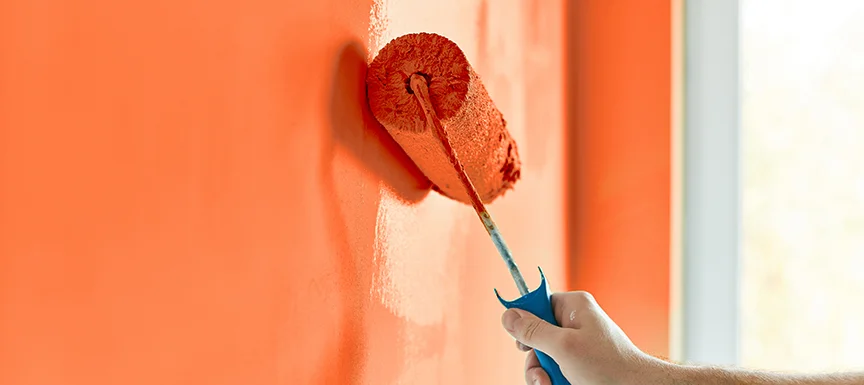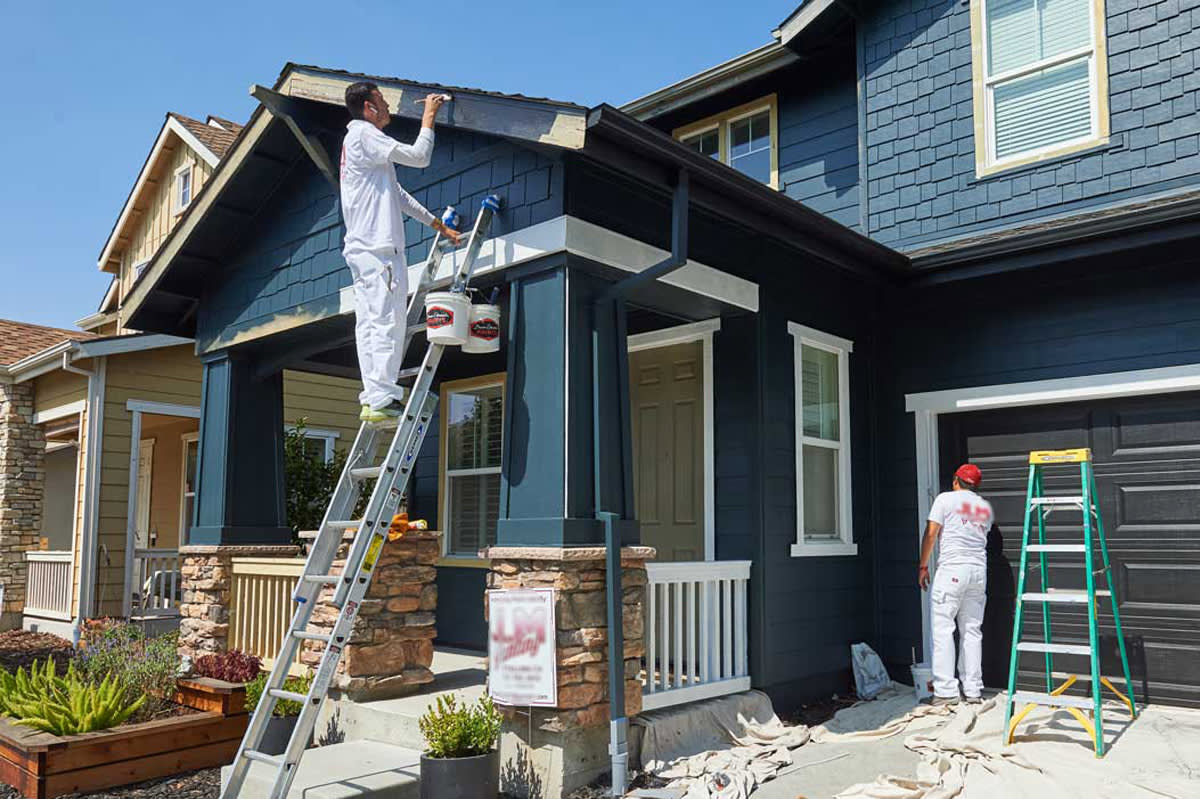Remain Ahead With New Paint Trends: Mixing Techniques for Modern Interiors

The Increase of Color Gradients in Inside Design
As designers increasingly look for ingenious methods to boost spaces, the increase of shade gradients in interior layout has gathered substantial attention. This method, identified by the smooth change between two or even more shades, enables a dynamic aesthetic result that can transform a regular space right into a dynamic setting. Shade slopes can stimulate emotions, influence assumptions of space, and produce focal points, making them a versatile option for numerous layout styles.
The application of gradients extends beyond wall surfaces; they can be effectively employed in furniture, textiles, and accessories. Designers commonly experiment with varying shades to attain deepness and intrigue, appealing to an array of aesthetics from minimalist to eclectic. Furthermore, the adaptability of slopes enables their use in both business and property setups, accommodating varied clients. As patterns progress, using color gradients represents a shift towards even more meaningful and individualized indoor spaces, reflecting individual tastes and lifestyles.
Welcoming Ombre Strategies for a Dynamic Look
Ombre strategies have actually become an enchanting selection for those wanting to add deepness and activity to modern-day interiors. This gradient impact shifts efficiently from one shade to one more, creating an aesthetically striking centerpiece in any space. Designers value ombre for its adaptability; it can be put on wall surfaces, furniture, or even ornamental accents, allowing for special expressions of style.
The technique functions especially well with soft shades, supplying a calm atmosphere, while vibrant colors can stimulate a space. Homeowners can trying out different color combinations, choosing contrasting shades for a significant impact or harmonious tones for a subtle impact. The application of ombre is not restricted to a solitary wall; it can prolong throughout a room, enhancing the assumption of area and light.
As a modern trend, ombre techniques deal with diverse preferences, permitting individuals to individualize their interiors and accept creativity in their layout approach. corpus christi tx paint shop.
Distinctive Walls: Layering Paint for Deepness and Rate of interest
Textured walls can greatly improve the aesthetic allure of modern insides by including deepness and passion. Methods for producing appearance, thoughtful shade combinations, and the right tools for layering are essential elements in accomplishing this result. Exploring these elements enables a dynamic and customized approach to indoor design.
Methods for Structure Production
Developing visual rate of interest in indoor rooms typically depends upon the artistic application of appearance. Numerous strategies can be utilized to attain this, such as sponging, dustcloth rolling, and stippling. Sponging includes making use of a moist sponge to apply a 2nd color over a base layer, developing a soft, multicolor effect. Cloth rolling, on the various other hand, utilizes a rolled dustcloth to apply paint, resulting in a more vibrant texture. Stippling utilizes a rigid brush or tool to swab paint onto the surface area, creating an unique pattern. Furthermore, layering various finishes, such as matte and shiny, can enhance deepness. These techniques not only supply visual appeal however also add to the total ambiance of modern insides, encouraging a responsive experience.
Color Combinations for Impact
Layering paint not only boosts structure yet likewise opens up a globe of color mixes that can substantially influence the mood of an area. By blending complementary shades, developers can develop a harmonious result that invites heat or coolness, depending on the wanted ambience. As an example, rich earth tones coupled with soft pastels can stimulate a calm setting, while strong, different colors can include vibrancy and power. In addition, integrating glossy or metal coatings within the layers can present a dynamic aesthetic element, catching light and enhancing the deepness of the color design. Eventually, thoughtful shade mixes via layering paint offer an opportunity to express individual design while changing normal walls into charming centerpieces.
Devices for Layering Result
Different tools are necessary for attaining a successful layering result in paint applications, which can transform wall surfaces right into charming aesthetic experiences. Brushes and rollers are fundamental, with diverse dimensions enabling different structures and finishes. Specialized devices like sponges and cloths can develop unique patterns and depth, while combination blades supply precision for more defined lines. For larger areas, using a stippling brush can add an intricate finish. Additionally, spray weapons can efficiently apply multiple layers for a smooth, also layer. Painters need to additionally take into consideration painter's tape to develop clean edges between layers. By using the right devices, one can properly boost the visual appeal of insides, making each wall surface an intriguing focal factor.

The Power of Shade Obstructing in Modern Spaces
As contemporary interior design remains to evolve, shade blocking becomes an effective technique that can transform rooms with vibrant visual impact. This approach entails the tactical positioning of contrasting shades to create defined areas within a space, boosting both the visual appeal and performance of the area. corpus christi paint store. By utilizing large swathes of color, designers can lead the eye and stress building elements, leading to a dynamic environment
Color barring is not limited to walls; it can additionally be put on furniture and design, permitting limitless personalization. Combining a vivid tone with a neutral tone can produce a striking focal point while maintaining balance. This technique motivates imagination, allowing home owners to share their personalities through special shade combinations. Ultimately, shade obstructing serves as an effective way to rejuvenate contemporary insides, making areas feel fresh, energetic, and aesthetically appealing.
Incorporating Metallics for a Glamorous Finish
Exactly how can metallics elevate the refinement of modern interiors? Metallic surfaces work as a striking focal point, including depth and visual rate of interest to spaces. They can change a basic space right into a classy resort via the refined interaction of light and representation. Developers usually suggest incorporating metallics in accent walls, ceilings, or furniture to develop a lavish atmosphere without frustrating the space.
Various metallic tones-- such as silver, bronze, and gold-- offer convenience, permitting homeowners to tailor their aesthetic. A soft gold can pass on heat, while a smooth silver can offer a contemporary touch. When coupled with neutral tones, metallics improve the total design, providing an innovative comparison that attracts the eye.
Integrating metallic paint right into trim or moldings can also raise building information, producing a sleek finish. Inevitably, the calculated use metallics can instill modern insides with glamour and refinement, making them genuinely enchanting.
Imaginative Use of Stencils for Distinct Patterns
Transforming wall surfaces with stencils can infuse modern-day insides with distinctive personality and design. This artistic strategy allows designers and homeowners to create personalized patterns that show individual visual appeals. Stencils can range from complex geometric styles to whimsical themes, allowing a vast range of expressions. By selecting contrasting colors, patterns can boost a space's aesthetic charm and act as prime focus without overwhelming the space.
Stencils are versatile; they can be used to numerous surface areas, including walls, furniture, and even ceilings. This adaptability makes stenciling a perfect option for DIY enthusiasts aiming to boost their home cost effectively. Furthermore, the simplicity of application and elimination allows for testing, making it possible for people to rejuvenate their decor with minimal effort. Inevitably, imaginative use of patterns not only transforms common surfaces however additionally offers a possibility for self-expression, making them a trending choice in modern interior decoration.
Blending Matte and Shiny Surfaces for Contrast
The interaction of matte and glossy finishes can develop a striking visual dynamic in contemporary insides. Designers frequently use this contrast to improve building functions and define spaces. Matte coatings, with their soft, non-reflective quality, can develop a sense of heat and affection, making them suitable for wall surfaces and larger surface areas. In contrast, glossy coatings reflect light, including vibrancy and depth, making them ideal for accents such as trim, moldings, or furnishings.
The combination of these appearances can assist the eye and emphasize prime focus within a room. For instance, coupling a matte-painted wall with shiny cabinetry can produce an advanced equilibrium. In addition, the careful application of both finishes can evoke various moods while improving the overall visual. As house owners increasingly look for personalized rooms, blending matte and shiny surfaces supplies a versatile method to accomplishing modern style and aesthetic interest in interior decoration.
Often Asked Concerns
What Tools Are Best for Blending Paint Techniques?
A variety of tools are perfect for mixing paint strategies, consisting of foam rollers, brushes with soft bristles, sponge applicators, and airbrushes. Each device provides distinct impacts, improving the blending process for different creative applications.
Exactly How Can I Deal With Mixing Mistakes?
To repair mixing errors, one should lightly sand the afflicted location, use a guide if essential, and after that thoroughly reapply paint using a soft brush or sponge to accomplish a smooth change and recover the wanted result.
Are There Specific Paint Brands Recommended for Mixing?
A number of paint brands are suggested for blending, including Benjamin Moore, Sherwin-Williams, and Behr. These brand names offer top quality finishes and a wide variety of shades that promote smooth changes and effective blending strategies in numerous interior projects.
Can I Mix Paint Without Specialist Assistance?
Yes, blending paint without professional aid is feasible. With method and the right devices, individuals can achieve desirable results. Numerous online tutorials and guides can aid in grasping blending methods for click here personal projects.

How Much Time Does Blended Paint Last on Wall Surfaces?
Combined paint can last anywhere from 5 to 10 years on wall surfaces, relying on elements such as the high quality of paint utilized, surface area prep work, and ecological conditions. Regular maintenance typically enhances longevity and appearance.
As designers increasingly seek innovative methods to improve areas, the increase of shade slopes in indoor design has gathered substantial attention. The method functions specifically well with soft tones, giving a serene ambiance, while vibrant shades can invigorate a room. Methods for producing structure, thoughtful color mixes, and the right tools for layering are crucial parts in attaining this effect. Layering paint not only enhances texture but additionally opens up a globe of shade combinations that can drastically influence the state of mind of a room. As contemporary interior style continues to develop, shade blocking arises as an effective method that can change rooms with vibrant visual impact.